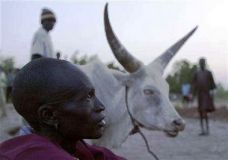Southern Sudanese give cows for love, not money
April 13, 2007 (JUBA) — Peace in southern Sudan turns people’s thoughts to marriage and investment — both of which traditionally involve giving, or keeping, cows. For the government, the cows are proving too much of a good thing.
 Parents-in-law are demanding cows promised as bride-price during the long war years, and this together with a sudden increase in ready cash has sent the price of cattle sky high.
Parents-in-law are demanding cows promised as bride-price during the long war years, and this together with a sudden increase in ready cash has sent the price of cattle sky high.
But the Sudanese are in the habit of keeping — not selling — their cows, and as traders in neighbouring Uganda take advantage of higher prices to sell their cattle into Sudan, the huge influx is creating a trade deficit, encouraging cattle-rustling, and damaging pastures.
The authorities are trying to change people’s attitudes and encourage them to turn to profit-based herding and to sell off surplus cows at regular intervals to make money.
It is not an easy task. Through decades of war, cows were one of the few stores of wealth for many people, especially the descendants of pastoralists who lived off their milk, blood or meat and counted a man’s wealth by the size of his herd.
“You have to pay cows for marriage, you cannot get it for free or money,” said Sarah Nyandeng, who lives in the southern capital Juba but comes from the pastoralist areas to the north.
Although conflict continues in the far western region of Darfur, a 2005 north-south accord has brought peace to the south after more than 20 years of civil war.
The inflow of cash that peace has brought, combined with a backlog of demand for cows as bride-price, has pushed up prices and reversed a previous flow of cattle out of Sudan to Uganda.
Since the January 2005 peace deal Sudanese have imported cows in unprecedented numbers, authorities say.
“During the war, we used to supply northern Uganda with more than 2,000 head of cattle a month,” said John Ogoso Kanisio, the Director General of Planning, Investment and Marketing at the Ministry of Animal Resources and Fisheries (MARF).
Now thousands of cattle are coming in from Uganda.
“We need to re-educate people about using cows for economic gain. Let us use our animals to bring us more money, rather than keeping them in high numbers,” Festo Kumbo, MARF’s minister, has said.
“We have more animals than Uganda but they are bringing them here. Our market is more lucrative because we have made them expensive,” he said, adding that Ugandans are free to bring in their cattle under a regional free trade agreement, Comesa.
MARRIAGE WITHOUT COWS?
Kumbo said selling cattle to market was the only solution to the problem of overgrazing as swollen herds begin to damage some of the south’s extensive pastures.
“Marriage without cows is as stable and good,” he ventured.
Juba resident Nyandeng said cattle have become more expensive, but one to two hundred head for a bride is normal in her area.
“Selling cows for money — this idea is new to him,” explained one Juba resident of the typical pastoralist. “With a lot of cows he thinks he’s rich, he’s happy, like he is really somebody. And then his children can marry.”
Juba residents cited different prices for cows during the war and said they varied from place to place, with many bartered rather than sold. But all agreed current prices, commonly up to $1,000 a cow in Juba and between $400 and $1,000 in more remote northern parts, are higher than before.
“The price has gone up since the peace,” said Ambraham Jada, who is not yet planning on parting with any of his herd.
“When the war was on everything was cheap, but now there is cash in circulation and the people’s purchasing power has increased,” said Kanisio, whose ministry is planning a survey of the regional market.
CATTLE AS BANKS
Cows are still considered the best way to invest in some parts of the south. “We lack banks so the best way for people in the risky areas is to buy cows,” Kanisio said.
Kanisio estimates the south has 8 to 10 million cattle. That would mean around one cow per person if estimates of the south’s population are correct.
The regional authorities see Uganda, Kenya and the Democratic Republic of Congo as the most obvious markets for exports, followed by northern Sudan, Egypt, Libya and the Gulf.
Kanisio said he also saw potential for marketing the cows internationally, because they have a 100 percent organic diet.
But serious investors will probably wait until the World Organisation for Animal Health declares Sudan free of the cattle disease rinderpest, Kansio added.
“Our hope is that the whole country is declared rinderpest free by 2008,” he said.
(Reuters)
